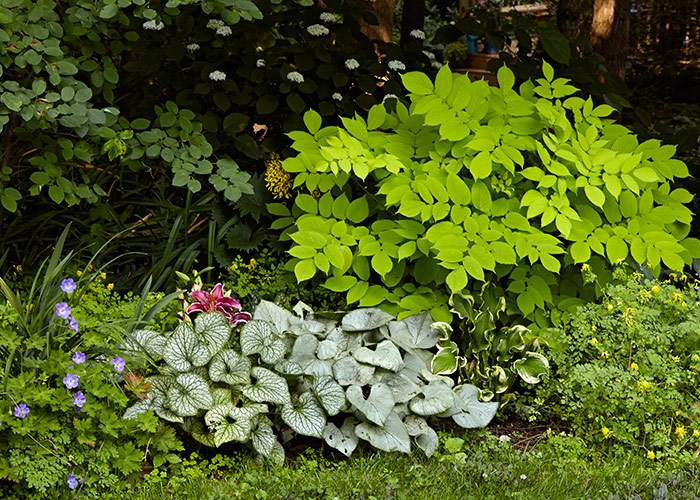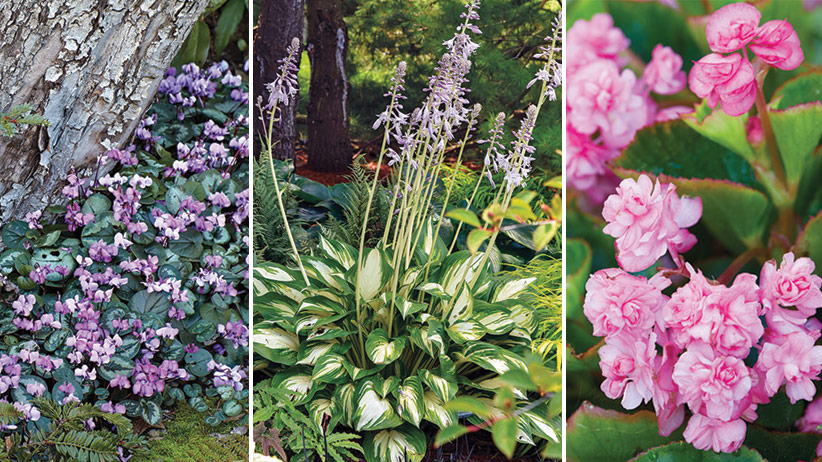Top picks: Perennials that boost interest the shade
There’s so much to love about gardening in the shade. Weed seeds don’t germinate as well, so there are fewer to pull, and the sun isn’t as intense, so you can easily relax. Though the temperature is the same in sun or shade, it can feel 10 to 15 degrees cooler when the sun isn’t hitting your skin. On a hot summer day, that’s a big plus! The challenge is creating colorful borders that you can really enjoy to accent those laid-back retreats.
Add a splash of color in shade
Shade gardens are often filled with loads of texture in subtle hues of green. That can look great but may not be your style. There are plenty of shade-loving plants that can make a splash with bright flowers and bold foliage. The colorful combination of ferns, hakonechloa and hosta below is just the beginning. Find plenty of eye-catching plants to help you grow a colorful shade garden with perennials and tender perennials here.
You Might Also Like:
Showy Shade Garden Combinations
Shade Garden Collection
Tour a Charming Shade Garden with Boxwood Topiary

Hosta (Hosta spp. and hybrids)
There are loads of hosta varieties that you can grow in shade gardens large and small. They all grow best with regular moisture in part to full shade. Though too much sun can cause crispy foliage for most, some varieties are affected by deep shade too.
Many gold-foliaged hostas tolerate sun without burning but become chartreuse in deep shade. So to get the brightest leaf color, grow gold hostas near the edge of the shade garden, where the sun is brighter. Blue hostas stay blue due to a waxy “bloom” that burns away in lots of sun, so place these in deeper shade. Variegated types aren’t usually too picky, tolerating a range of light conditions.
Don’t forget hosta flowers!
The scapes, or flowering stems, on hostas vary in height. Some sit right on top the foliage while others, such as those of ‘Miss America’ above, tower over the plant. Whichever variety you have, hummingbirds love the blooms. Once the they finish, cut the scapes off below the foliage for a tidier look.
Type: Perennial
Blooms: White, purple or lavender blooms in late spring to early fall
Foliage: Variegated or solid leaves in green, blue, white, gold or chartreuse
Light: Part to full shade
Soil: Moist, well-drained
Size: 3 to 72 in. tall, 6 to 72 in. wide
Hardiness: Cold hardy in USDA zones 3 to 9
Plant Source: NH Hostas, 603-879-0085

Cyclamen (Cyclamen spp. and hybrids)
Although cyclamen is a favorite gift plant from the florist’s shop, many of its relatives make fantastic shade garden plants as well. There are lots of different species, but these three spring bloomers are easy to grow in the garden: purple (Cyclamen purpurescens), round-leaved (C. coum) and ivy-leaved (C. hederifolium), shown above.
Though hardy cyclamen needs regular moisture in spring, well-drained soil is essential or the corms will rot. Plants go dormant during summer and prefer to stay dry then — no need for extra watering. Feeding isn’t necessary either unless the soil is lean. If that’s the case, scratch a shovelful of compost into the soil every year or two when plants are dormant in fall. Plant the corms of spring-flowering cyclamen in fall a couple of inches below the soil’s surface, and cover them with an inch or two of bark mulch in zones 6 and colder for added protection. Then move the mulch away in late winter to allow room for these small plants to take off.
Type: Corm
Blooms: Pink, magenta, white or bicolor blooms in early spring or fall
Foliage: Blue-green leaves with silvery patterns
Light: Full sun to part shade
Soil: Average or moist, well-drained
Size: 2 to 16 in. tall and wide
Hardiness: Cold hardy in USDA zones 5 to 8
Plant Source: Edelweiss Perennials

Foamflower (Tiarella spp. and hybrids)
If you struggle to find plants for heavy shade, foamflower is a great choice. This woodland plant thrives there, and deer tend to pass it by. Provide humus-rich soil that’s well drained, and foamflower will spread by stolons to form small clumps. Then its loose pink or white bottlebrush blooms will provide a bright spot of color in spring and last for up to six weeks. Most varieties have burgundy markings on the leaves, similar to Stargazer Mercury in the photo above. The color is more intense in cool weather, and the foliage stays evergreen in mild winter areas.
Type: Perennial
Blooms: Pink or white bottlebrush flowers in spring
Foliage: Maple-leaf-shaped to deeply lobed green or green with burgundy markings
Light: Part to full shade
Soil: Moist, well-drained
Size: 2 to 28 in. tall, 6 to 36 in. wide
Hardiness: Cold hardy in USDA zones 3 to 9
Plant Source: Local garden centers

Ligularia (Ligularia spp. and hybrids)
The big leathery leaves of ligularia are show-stopping in a shady border. Depending on the species or variety, ligularia foliage is either round or deeply lobed. Most varieties have green foliage, but some, such as ‘Britt Marie Crawford’, have burgundy leaves. Ligularia’s yellow daisy-shaped blooms are arranged either in clusters or spikes. ‘Bottle Rocket’, above, is particularly floriferous and compact. Consistent moisture and plenty of shade are the keys to great-looking foliage that doesn’t burn or die back.
Type: Perennial
Blooms: Yellow daisy-shaped blooms arranged in clusters or spikes in summer
Foliage: Green or burgundy foliage is round, deeply lobed or heart shaped
Light: Part to full shade
Soil: Moist, well-drained
Size: 1 to 6 ft. tall, 1 to 4 ft. wide
Hardiness: Cold hardy in USDA zones 3 to 9
Plant Source: Bluestone Perennials, 800-852-5243

Pulmonaria (Pulmonaria spp. and hybrids)
Pulmonaria’s early spring flowers and gorgeous foliage look great all season, even in dry soil. Most varieties are green with silver spots, but ‘Silver Bouquet’ above adds extra shimmer to shade with solid silver leaves.
Many varieties (including ‘Silver Bouquet’) have blooms that change from pink to purple to blue. There are a few, such as pink ‘Raspberry Splash’ or white ‘Sissinghurst White’, whose flowers don’t change color. As new foliage emerges, the flower stems fade, leaning toward the soil. That’s a great time to snip them off near the base to tidy up the look and make room for new growth. Pulmonaria has prickly leaves, so it’s a good idea to wear gloves when you’re working with it.
Type: Perennial
Blooms: Blue, pink, white or purple in spring
Foliage: Narrow or broad green leaves are spotted, streaked or solid silver
Light: Part to full shade
Soil: Average, well-drained
Size: 6 to 18 in. tall, 10 to 40 in. wide
Hardiness: Cold hardy in USDA zones 3 to 9
Plant Source: Plant Delights Nursery, 919-772-4794

Bugleweed (Ajuga reptans)
This vigorous drought-tolerant ground cover spreads by stolons to fill in between plants or pavers along a shady path. There are lots of hybrids with different foliage colors. ‘Black Scallop’ above has green foliage that matures to glossy deep purple as the season progresses. ‘Burgundy Glow’ has tricolor creamy-white, burgundy and purple leaves. For a pop of bright-yellow foliage, give ‘Tropical Toucan’ a try. Once established, plants don’t need much care. Some varieties will reseed, but the colorful foliage types won’t come true and new plants will most likely be green.
Type: Perennial
Blooms: Purple, blue, white or pink spikes in spring
Foliage: Green, burgundy, gold, purple or tricolor
Light: Full sun to part shade
Soil: Average or moist, well-drained
Size: 4 to 10 in. tall, 10 to 24 in. wide
Hardiness Cold hardy in USDA zones 3 to 9
Plant Source: Local garden centers

Aralia (Aralia cordata)
‘Sun King’ has golden yellow leaves that add a bright spot of color in part-shade areas. Plants grow in heavy shade just fine but will be more chartreuse there. In midsummer, tiny white flowers arrive to feed the local bees, and birds gobble up the purple-black berries that form in late summer. (The raw berries can cause stomach upset and have lots of seeds, so people don’t usually eat them.)
Give ‘Sun King’ humus-rich soil and regular moisture so it can reach its full height and width. This hefty size makes it look like a shrub in the border, but plants die to the ground in late fall. Just cut back dead stems in early spring to make way for new growth and you can enjoy ‘Sun King’ every year.
Type: Perennial
Blooms: Insignificant white flowers in summer
Foliage: Green or gold
Light: Part to full shade
Soil: Average or moist, well-drained
Size: 3 to 4 ft. tall and wide
Hardiness: Cold hardy in USDA zones 3 to 9
Plant Source: White Flower Farm, 800-503-9624
You Might Also Like:
Colorful Shade Garden Ideas
This or That: ‘Sun King’ Aralia Vs. ‘Gold Heart’ Bleeding Heart
Plants with Unique Variegated Foliage

Caladium (Caladium hybrids)
Classic caladium provides nonstop foliage color for containers or shady borders. Its arrowhead leaves come in red, white, green, pink or a combination of those colors, as you can see on ‘Miss Muffet’ above. Don’t plant these warm-weather lovers until soil temperatures are at least 65 degrees F or they could rot. If you live in cold winter regions, start tubers indoors six to eight weeks before planting outside.
Caladiums are heavy feeders and like regular moisture. Apply a couple inches of mulch at planting, and feed monthly with a liquid plant food that’s low in nitrogen (the first number on the fertilizer label). Lots of nitrogen or high soil temperatures (over 85 degrees F) cause caladium leaves to produce more green than the bright colors they’re known for.
Type: Tuber
Blooms: Rarely produces a white to pink bloom in summer
Foliage: Arrowhead-shaped leaves mottled, splashed or speckled with red, white or pink
Light: Part to full shade
Soil: Average or moist, well-drained
Size: 8 to 24 in. tall, 6 to 24 in. wide
Hardiness: Cold hardy in USDA zones 9 to 11
Plant Source: Local garden centers

Wax begonia (Begonia semperflorens)
Wax begonias are some of the most reliable flowers you can grow in shade. They bloom from late spring to frost with no need for deadheading or extra watering. There are countless varieties to choose from, and most are part of a series with the same height and habit in a range of flower or foliage colors.
- You can edge the front of your border with the pint-sized Ambassador series, which grows just 6 to 8 inches tall with pink, red or white flowers and green foliage.
- Try the Cocktail series, which is 8 to 10 inches tall with bronze foliage.
- The Double Up™ series is covered in fancy flowers and reaches 18 inches tall — perfect for midborder color in shade. It blooms in pink, red or white.
Type: Tender perennial (Usually grown as an annual)
Blooms: Pink, red, orange, white or bicolor blooms from spring to frost
Foliage: Glossy round green or burgundy leaves
Light: Full sun to full shade
Soil: Average or moist, well-drained
Size: 6 to 34 in. tall, 6 to 12 in. wide
Hardiness: Cold hardy in USDA zones 10 to 11
Plant Source: Local garden centers

Wishbone flower (Torenia hybrids)
The charming blooms of wishbone flower offer spring-to-frost container color on a shady patio or shepherd’s hook. Most series, including Kauai™ and Hi-Lite, have a mounded habit that works well to fill the gap between plants in your pots. But a few, such as the Catalina® and Summer Wave® series, will trail, softening the edge of any container or hanging basket.
Caring for wishbone flower is simple. Water regularly and give plants plenty of shade so the foliage doesn’t burn. There’s no need to deadhead; these plants are self-cleaning, which means the blooms fall off on their own. You may need to cut stems back by a third in summer if they get leggy.
Type: Tender perennial (Usually grown as an annual)
Blooms: White, rose, purple, yellow or blue blooms often with a contrasting throat from
spring to frost
Foliage: Small oval green leaves with toothed edges
Light: Part to full shade
Soil: Average, well-drained
Size: 2 to 16 in. tall, 8 to 12 in. wide
Hardiness: Cold hardy in USDA zones 10 to 11
Plant Source: Local garden centers

Coleus (Plectranthus hybrids)
Coleus has been keeping gardens colorful for generations. Sure, it’s easy to grow, but the biggest reason is because it comes in all kinds of leaf shapes and colors. Kong Jr.™ Scarlet above has broad heart-shaped leaves splashed with burgundy on plants that grow 18 to 24 inches tall and 20 to 35 inches wide. But that’s just the beginning of what you’ll find in the garden center.
Coleus needs regular watering, and some varieties need deadheading if you don’t like the look of their spiky blooms. More recent introductions, such as ‘Wicked Witch’ or those in the FlameThrower™ series, tend to bloom so late in the season that there’s no need. Be sure to check the tag when you’re shopping for coleus. They grow just fine in sun or shade (those in sun may need more watering), but the foliage color or pattern may be different if it’s not growing in the recommended light conditions.
Type: Tender perennial (Usually grown as an annual)
Blooms: Lavender spikes in late summer
Foliage: Wide range of leaf shapes, colors and patterns
Light: Full sun to full shade
Soil: Moist, well-drained
Size: 6 to 48 in. tall, 10 to 40 in. wide
Hardiness: Cold hardy in USDA zones 10 to 12
Plant Source: Local garden centers
















